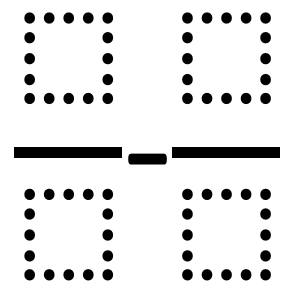Directions: Using the digits 1 to 9 at most one time each, fill in the boxes to make the smallest (or largest) difference.

Hint
How can we make a really big fraction? How can we make a really small difference from fractions? If improper fractions are allowed, the numerators should be as big as possible and the denominators as small as possible. Otherwise, we want the fractions to each be as close to one as possible.
Answer
Smallest: 4/7 – 5/9 (found by Shelly Waite) or largest: 9/1 – 2/8 (found by Kim’s students)
Source: Robert Kaplinsky
 Open Middle®
Open Middle®



My group of 4th grade teachers really enjoyed this task today. We talked about changing the subtraction sign to an inequity symbol. This would help with understanding of uncommon denominator comparisons which they felt is a huge challenge for 4th graders. I was surprised to not see this task in 5th grade which is when students are expected to add and subtract with uncommon denominators in CCSS. Perhaps you can add it there too???
Thanks Shelah. You are totally right that this was categorized as a 4th grade problem when it should be 5th. I’ve changed the grade level accordingly.
Ohh, I like the “also check out” feature. I haven’t noticed that before!
Yeah, that’s a new feature in this template. Just showed up one day.
I did this today with a group of 5th graders! They loved the “riddle”, thank you! As we were exclusively working on difference today (per the directions), we found the largest difference would be 9/1 – 2/8, your solution offers 9/1 + 8/2. Thoughts?
Oh. Good catch Kim. The answers seem to be for the addition version of this problem. Thanks for the heads up.
A group of us interpreted the words “smallest difference” differently here, and boy, did we have interesting discussions! Amazing how these words seem so… common… universally understood… and yet, through different interpretations, we approached this problem in unique ways.
What are your thoughts on the “smallest difference” being obtained by taking 2/8 – 9/1 to result in -8 3/4?
How interesting is it that this would be a non-issue for this problem if we’d only been asked to find the “largest difference”?
A seemingly simple fraction subtraction problem just might be more “open” than meets the eye.
Hi Cathy. Yeah, this has been an issue for many problems like this. Generally when I use this with a class, the conversation talks about least difference meaning closest together on a number line.
I gave my sixth graders this problem and immediately they asked if the answer could be negative. I originally was thinking the answer would be positive – boy did they open my eyes. They had fun trying to beat each other to a lower answer. They got 2/8 – 9/1.
Yeah, I think that conversations like this are part of the fun of the problem. See also how I replied to Cathy above.
The answer you have given is incorrect for tge smallest difference. The value of the expression 8/9-6/7=2/63, the 4th smallest possible difference. The answer is 4/7-5/9=1/63. This problem is generally ecepted to be looking for a positive value.
Awesome! Thanks so much Shelly. I’ll update the answer accordingly.
What’s wrong with 1/4 – 2/8 = 0?
Because 0 is not one of the digits. it said the numbers 1 to 9. 0 is not in there.
I agree with Suzy Krutsch. Difference of two equivalent fractions such as 1/4 – 2/8 or 1/2 – 3/6 should give you the smallest nonnegative difference (since grade 5 does not have concept of negative fractions yet).
Greatest difference:
8/1 – 9/7 = 6.714285714285714
Smallest difference greater than 0:
abs(3/7 – 4/9) = 0.015873015873015872
abs(4/7 – 5/9) = 0.015873015873015817
Smallest difference:
1/2 – 3/4
1/2 – 3/5
1/2 – 3/6
1/2 – 4/8
1/3 – 2/6
1/4 – 2/8
2/1 – 6/3
2/1 – 8/4
2/3 – 4/6
2/3 – 6/9
2/4 – 3/6
2/6 – 3/9
3/1 – 6/2
3/2 – 6/4
3/2 – 9/6
3/4 – 6/8
3/6 – 4/8
4/1 – 8/2
4/2 – 6/3
4/3 – 8/6
6/2 – 9/3
6/3 – 8/4
with the subtrahend and minuend being exactly equal to each other, meaning the difference is 0.
Smallest negative result:
2/8 – 9/1 = -8.75
the smallest you could make 8/9-0/1
The smallest you could make is 4/8-1/2, which would equal 0 not 1/63, which is barely greater in value.
If you did not want negatives